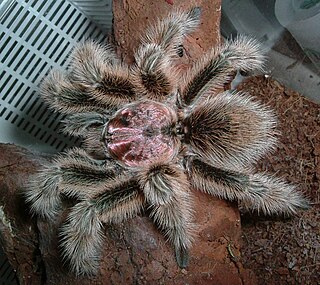
The family Dipluridae, known as curtain-web spiders are a group of spiders in the infraorder Mygalomorphae, that have two pairs of booklungs, and chelicerae (fangs) that move up and down in a stabbing motion. A number of genera, including that of the Sydney funnel-web spider (Atrax), used to be classified in this family but have now been moved to Atracidae.

The family Cyrtaucheniidae, known as wafer-lid trapdoor spiders, are a widespread family of Mygalomorphae spiders.

Grammostola is a genus of South American tarantulas that was first described in text by Eugène Louis Simon in 1892. These medium- to large-sized spiders are native to tropical South America, and are usually brown in color, with pinkish or orangish-red hairs. The very docile Chilean rose tarantula is popular as a beginner's spider among tarantula enthusiasts.
Plesiolena is a small genus of South American mygalomorph spiders in the family Actinopodidae. It was first described by Pablo A. Goloboff and Norman I. Platnick in 1987, and it has only been found in Chile. The name is a combination of "plesiomorphy" and the genus Missulena. As of November 2021 it contains only 2 species: P. bonneti and P. jorgelina.

Nemesiidae, also known as funnel-web trapdoor spiders, is a family of mygalomorph spiders first described by Eugène Simon in 1889, and raised to family status in 1985. Before becoming its own family, it was considered part of "Dipluridae".

Diplura is a genus of South American curtain web spiders that was first described by C. L. Koch in 1850. It is found in South America and Cuba belonging to the subfamily Diplurinae. They possess a lyra on their prolateral maxillae. Diplura species can be distinguished from Trechona sp. by the number of setae on this lyra. They differ from Harmonicon sp. by the leg formula and the shape of the lyra bristles.

Cyriocosmus is a genus of tarantulas that was first described by Eugène Louis Simon in 1903. They are small to medium spiders, with a bicolored or one same color carapace.

Idiops is a genus of armored trapdoor spiders that was first described by Josef Anton Maximilian Perty in 1833. It is the type genus of the spurred trapdoor spiders, Idiopidae. Idiops is also the most species-rich genus of the family, and is found at widely separated locations in the Neotropics, Afrotropics, Indomalaya and the Middle East. Females live in tubular burrows lined with a thick layer of white silk. These typically have a D-shaped lid that fits into the entrance like a cork, and some burrows have two entrances. The lid may consist of mud, moss or lichen, which is bound below by a thick layer of silk. As in all genera of this family, the anterior lateral eyes (ALE) are situated near the clypeal margin, far in front of the remaining six eyes, which are arranged in a tight group. The males which are smaller in size, wander about or occasionally live in burrows. Like other mygalomorphs, they are relatively large and long-lived. Forest clearance and agricultural practices that loosen the soil and enhance erosion, besides soil removal for brick making have been pointed out as serious threats to some Indian species. Species ranges are poorly known – in India for instance, most species are known only from their type localities.
Cyclosternum is a genus of tarantulas that was first described by Anton Ausserer in 1871.
Acanthogonatus alegre is a mygalomorph spider of Chile, its name using the Spanish word for “happy”, referring to the aspect of a happy face that the female epigastrium has in posterior view. Females are recognized by the epigastrium produced in a membranous extension and the long, slender and bifurcated spermathecae.
Chaco is a genus of spider in the family Pycnothelidae.
Stenoterommata is a genus of South American araneomorph spiders in the family Pycnothelidae. It was first described by E. L. Holmberg in 1881. Originally placed with the Ctenizidae, it was transferred to the funnel-web trapdoor spiders in 1985, then to the Pycnothelidae in 2020. It is a senior synonym of Ctenochelus.
Tmesiphantes is a genus of Brazilian tarantulas in the subfamily Theraphosinae that was first described by Eugène Louis Simon in 1892. The genera Magulla and Melloleitaoina were brought into synonymy in 2019.

Homoeomma is a genus of South American tarantulas that was first described by Anton Ausserer in 1871. It is considered a senior synonym of Calopelma, Butantania, and of Cyclothoracoides. These tarantulas are usually quite small and usually burrow a few centimeters under a rock or log.
Hermacha is a genus of mygalomorphae spiders in the family Entypesidae. It was first described by Eugène Louis Simon in 1889. Originally placed with the Ctenizidae, it was transferred to the funnel-web trapdoor spiders in 1985, then to the Entypesidae in 2020. It is a senior synonym of Damarchodes and Hermachola.
Pycnothele is a genus of South American mygalomorph spiders in the family Pycnothelidae. First described by Ralph Vary Chamberlin in 1917, it was moved to the funnel-web trapdoor spiders in 1985, but moved back to Pycnothelidae in 2020. It is a senior synonym of Agersborgia and Androthelopsis.

Polybetes is a genus of South American huntsman spiders that was first described by Eugène Louis Simon in 1897. It is a senior synonym of Leptosparassus and Streptaedoea.

Pycnothelidae is a family of mygalomorph spiders first described in 1917. It was downgraded to a subfamily of the funnel-web trapdoor spiders in 1985, but returned to family status in 2020.










